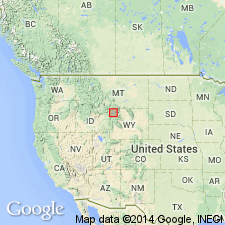
- Usage in publication:
-
- Madison River Basalt*
- Modifications:
-
- Named
- Dominant lithology:
-
- Basalt
- AAPG geologic province:
-
- Yellowstone province
Summary:
Named for scattered exposures south and west of Gallatin Range to Madison Canyon and eastern Madison Valley, near West Yellowstone, Yellowstone National Park, WY, Yellowstone province. Type area is the basalt-covered uplands west of the south end, Gallatin Range, south of upper Maple Creek in northwest part of the Park. Is a gray basalt with moderately abundant plagioclase phenocrysts, and relatively rare olivine phenocrysts. Contains markedly more potassium, iron, titanium, phosphorus, fluorine, rubidium, lead, and uranium, and contains less calcium and magnesium than other basalts in area of similar silica content. Some flows cover several sq km and are more than 50 m thick. Lies on eroded surface of Lava Creek Tuff (new) of Yellowstone Group (raised in rank). Is younger than Roaring Mountain Member (new) of Plateau Rhyolite (new). Is younger than at least part of Swan Lake Flat and Falls River Basalts. Is older than early Wisconsin deposits and probably older than canyon-cutting contemporaneous with Yarmouth Interglaciation. Is part of the third volcanic cycle of Quaternary Yellowstone Plateau. Stratigraphic table; cross sections.
Source: GNU records (USGS DDS-6; Denver GNULEX).
For more information, please contact Nancy Stamm, Geologic Names Committee Secretary.
Asterisk (*) indicates published by U.S. Geological Survey authors.
"No current usage" (†) implies that a name has been abandoned or has fallen into disuse. Former usage and, if known, replacement name given in parentheses ( ).
Slash (/) indicates name conflicts with nomenclatural guidelines (CSN, 1933; ACSN, 1961, 1970; NACSN, 1983, 2005, 2021). May be explained within brackets ([ ]).

